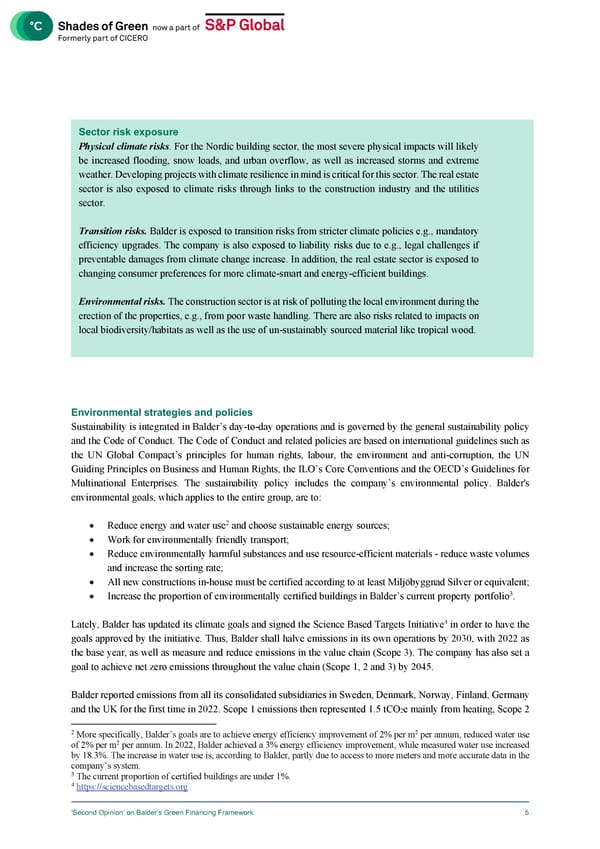‘Second Opinion’ on Balder ’s Green Financing Framework 5 E nvironmental strategies and policies Sustainability is integrated in Balder’s day - to - day operations and is governed by the general sustainability policy and the Code of Conduct. The Code of Conduct and related policies are based on international guidelines such as the UN Global Compact’s prin ciples for human rights, labour, the environment and anti - corruption, the UN Guiding Principles on Business and Human Rights, the ILO’s Core Conventions and the OECD’s Guidelines for Multinational Enterprises. The sustainability policy includes the company ’s environmental policy. Balder's environmental goals, which applies to the entire group, are to: • Reduce energy and water use 2 and choose sustainable energy sources; • Work for environmentally friendly transport; • Reduce environmentally harmful substances a nd use resource - efficient materials - r educe waste volumes and increase the sorting rate; • All new constructions in - house must be certified according to at least Milj ö byggnad Silver or equivalent ; • Increase the proportion of environmentally certified build ings in Balder’s current property portfolio 3 . Lately, Balder has updated its climate goals and signed the Science Based Targets Initiative 4 in order to have the goals approved by the initiative. Thus, Balder shall halve emissions in its own operations by 2030, with 2022 as the base year, as well as measure and reduce emissions in the value chain (Scope 3). The company has also set a goal to a chieve net zero emissions throughout the value chain (Scope 1, 2 and 3) by 2045. Balder reported emissions from all its consolidated subsidiaries in Sweden, Denmark, Norway, Finland, Germany and the UK for the first time in 2022 . Scope 1 emissions then re presented 1.5 tCO 2 e mainly from heating , Scope 2 2 More specifically, Balder’s goals are to achieve energy efficiency improvement of 2% per m 2 per annum, reduced water use of 2% per m 2 per annum. In 2022, Balder achieved a 3% energy efficiency improvement, while measu red water use increased by 18.3% . The increase in water use is , according to Balder, partly due to access to more meters and more accurate data in the company ’ s system. 3 The current proportion of certified buildings are under 1%. 4 https://sciencebasedtargets.org Sector risk exposure Physical climate risks . For the Nordic building sector, the most severe physical impacts will likely be increased flooding, snow loads, and urban overflow, as well as in creased storms and extreme weather. Developing projects with climate resilience in mind is critical for this sector. The real estate sector is also exposed to climate risks through links to the construction industry and the utilities sector. Transition ri sks. Balder is exposed to transition risks from stricter climate policies e.g., mandatory efficiency upgrades. The company is also exposed to liability risks due to e.g., legal challenges if preventable damages from climate change increase. In addition, th e real estate sector is exposed to changing consumer preferences for more climate - smart and energy - efficient buildings. Environmental risks. The construction sector is at risk of polluting the local environment during the erection of the properties, e.g., from poor waste handling. There are also risks related to impacts on local biodiversity/habitats as well as the use of un - sustainably sourced material like tropical wood.
 Fastighets AB Balder Page 4 Page 6
Fastighets AB Balder Page 4 Page 6